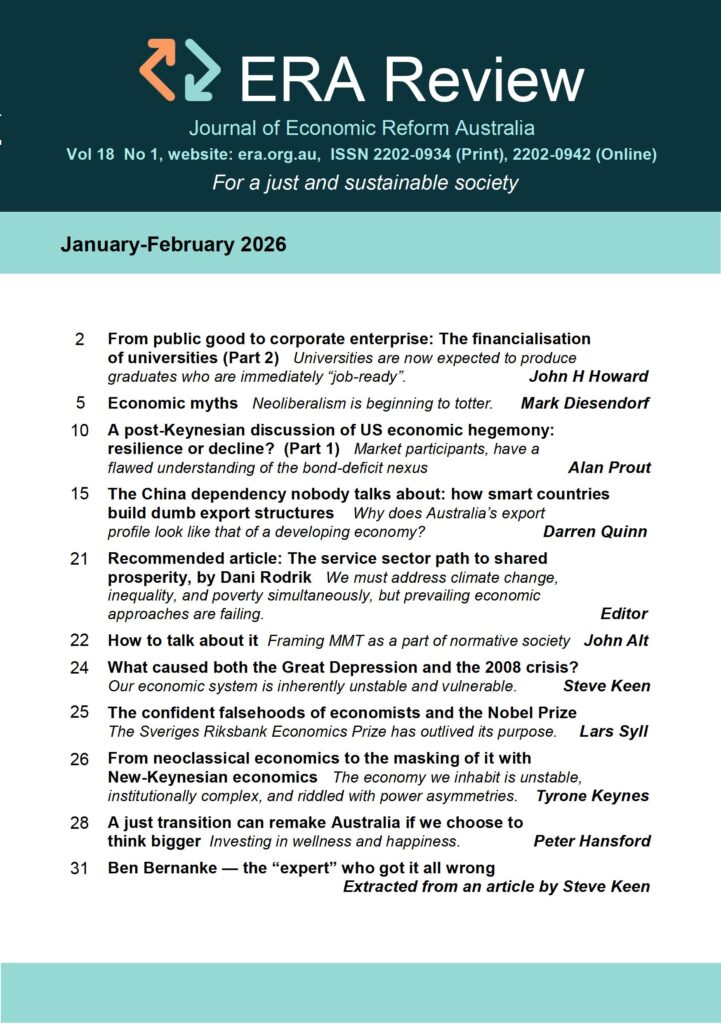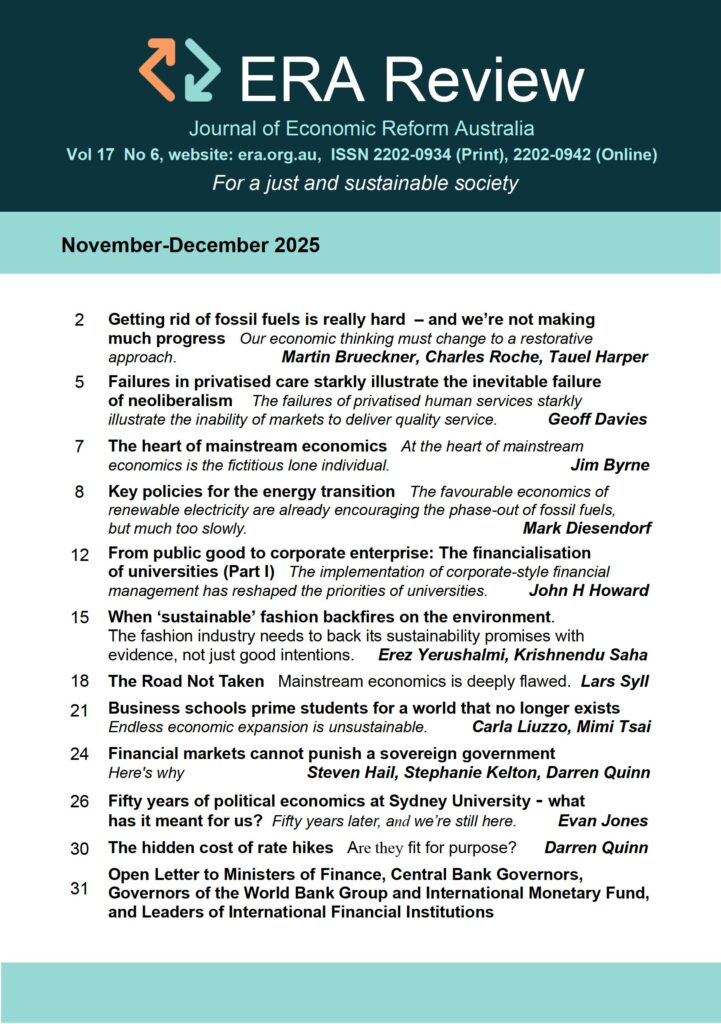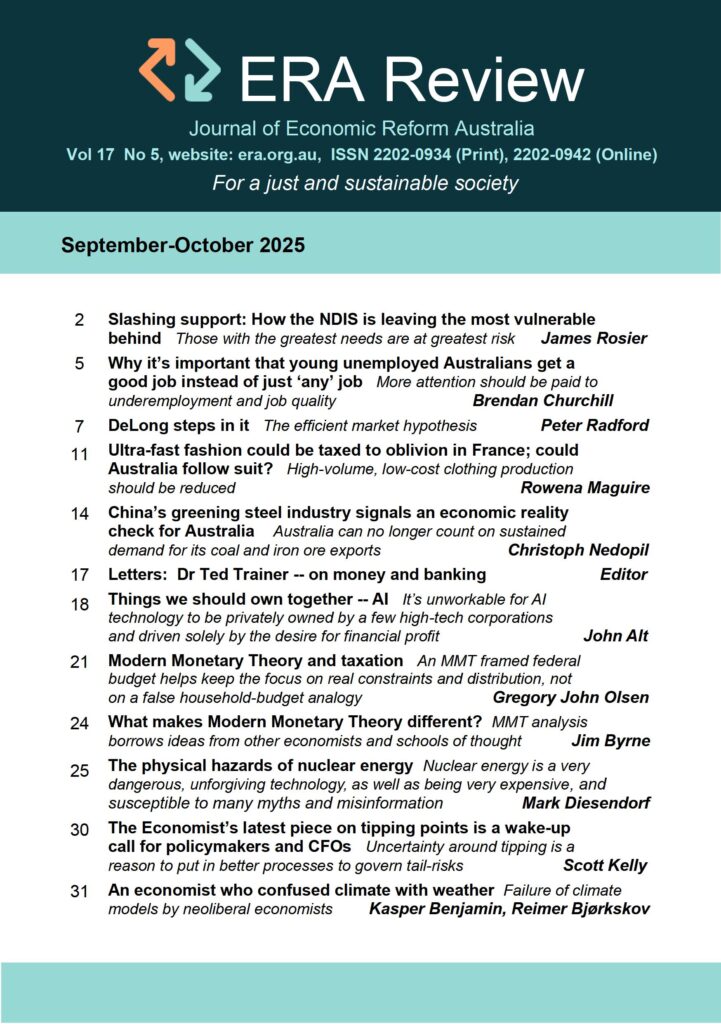An alternative alternative economics
How socially engaged Buddhism compares with established heterodox schools Nick Johnson
This post compares 4 prominent nonmainstream, or heterodox, schools of economic thought with socially engaged Buddhism (SEB). The latter is explored in Joel Magnuson’s book From Greed to Wellbeing. In what follows, I will detail both the similarities and the differences of his main ideas with Institutionalism, post-Keynesianism, Marxism and Ecological Economics. This is not intended to be a comprehensive survey of any of these schools. Rather I want to emphasise where Magnuson’s proposals for SEB overlap, on the one hand, and differ, on the other.
Briefly, Magnuson’s book argues that our modern capitalist economic system is failing to promote universal wellbeing, stability, equity and environmental sustainability, and instead rests on an unquenchable desire for ever greater consumption as part of an ideology of endless economic growth. There is thus an urgent necessity to resolve our evolving economic, social and environmental crises by overcoming, both individually and institutionally, what are known in Buddhism as the ‘three fires’ of greed, aggression and delusion. This requires both individual action and institutional reform, and the two are inextricably bound together. Individual self-transformation is the foundation for institutional reforms. The latter might be the creation of new forms of organisation, such as local banks sustainably serving local development of the economy, society and environment, aiming to promote wellbeing and stability.

There is a need for the widespread overcoming of the ‘hamster wheel’ of growth and increased consumption as the path to happiness, which tends to prove short-lived and unsustainable. Institutional change in society needs to happen from the bottom up in order to be sustained in the long run. We must recognise the importance of such change as a means to affect largescale society-wide transformation, serving the economy, society and the planetary environment. Institutions shape, enable and constrain individual behaviour and when those institutions change, individual behaviour can evolve more rapidly. A few individuals changing by themselves will not be enough. For Magnuson, such change is vital. We cannot rely solely on technological advancement to solve all our problems.
The key points where Magnuson’s SEB overlaps and differs from the schools of economic thought considered here are presented for ease of reference. For each school the first headed section describes its similarities with SEB, and the second headed section describes SEB’s differences from that school. There is some inevitable repetition, as the four heterodox schools overlap to some extent with each other.
Institutional economics – the similarities:
1. Takes a holistic or systemic perspective on the economy and society.
2. Examines both human agency and social structure, and their interaction.
3. Individuals shape institutional change.
4. The economy is embedded within society.
5. Takes an interdisciplinary perspective, drawing on disciplines outside economics such as politics, sociology and psychology.
6. Sees the economy and society as dynamic evolutionary systems subject to constant change.
7. Sees this systemic change as requiring both individual and institutional change, and evolving policies which necessarily support these processes.
8. Critical of aspects of consumption under capitalism.
SEB – the differences with institutional economics:
1. Proposes a different conception of the individual, who is suffering owing to unquenchable desires which give rise to the ‘three fires’ of greed, aggression and delusion. An example of the last might be the idea that more is always better, and that economic growth can continue forever.
2. There is a need for individual self-transformation to quieten the three fires, and to develop the qualities of compassion, creativity and cooperation, which are latent within everyone.
3. Change begins with the individual and spills out into wider institutional and social change. This is more lasting than policies which are in essence more top-down or statist.
4. Argues for the impermanence of all in existence, and the benefits to wellbeing of accepting this realisation.

Post-Keynesian economics – the similarities:
1. Takes a more holistic, systemic, social perspective on the economy, with more emphasis on macroeconomics than microeconomics, at least when compared with much of the mainstream.
2. Critical of liberalised financial systems.
3. dominated by speculation, which are seen to give rise to instability and periodic crises.
4. Critical of excessive inequality, both morally and socially, as well as the way it can negatively impact the economy.
5. The economy is seen as a dynamic, disequilibrium system, subject to constant change.
SEB – the differences with postKeynesian economics:
1. No macro-micro distinction. Radically holistic, since everything is seen as connected to everything else.
2. Individual and institutional dissolving of the three fires can reduce financial system dysfunction more sustainably than top-down, state-driven regulation: “governments cannot legislate away greed”.
3. Questions the ideology of endless growth in GDP and consumption, and supports the development and use of alternative indicators of progress.
4. Bottom-up change starts with individual self-transformation.
5. Social classes such as capital and labour are not mentioned, with more emphasis placed on the individual, though the latter holistically reflects the wider society, and vice versa.
6. Argues for the impermanence of all in existence, and the benefits to wellbeing of accepting this realisation.
Marxist economics – the similarities:
1. Takes a holistic, social perspective on the economy and society.
2. Embraces the prospect of social change, potentially beyond capitalism.
3. Everything is seen as connected to everything else.
4. Takes an interdisciplinary approach to social science.
5. Critical of the instability (economic, financial and social), destructiveness of livelihoods and inequality generated by capitalism.
6. Views society and the economy as dynamic and subject to constant change: “all that is solid melts into air”.
SEB – the differences with Marxist economics:
1. Change starts with individual self-transformation.
2. No mention of socialism.
3. Sustainable economic and social change starts from the bottom up, rather than being (for some Marxists) statist or top-down.
4. Accepts that markets and money are vital aspects of society and the economy, even in a transformed system.
5. Strongly critical of the ideology of endless economic growth.
6. Supports developing alternative indicators of progress to GDP.
7. No labour theory of value.
8. No mention of class struggle, conflict or violent revolution. Indeed, the individual human emotions which produce such outcomes can be transformed and tamed via healthful practices such as mindfulness.
9. The effective change of individuals from within is more sustainable than those that start with top-down statedriven policies.
10. Argues for the impermanence of all in existence, and the benefits to wellbeing of accepting this realisation.
Ecological economics – the similarities:
1. Takes a holistic, social, environmental approach to the economy and society, with an emphasis on sustainable development.
2. The economy is emergent from and dependent upon society, which is in turn emergent from and dependent upon nature.
3. Takes an interdisciplinary approach, drawing on a variety of social as well as natural sciences.
4. Strongly critical of the ideology of endless economic growth.
5. Supports the development and use of alternative indicators of progress to GDP.
6. Often supports bottom-up, community-driven development.
7. Focuses on greater equality and preserving the environment as part of sustainable development.
8. Emphasises greater human wellbeing and happiness as goals of development, rather than ever greater consumption.
9. Emphasises institutional change for sustainable development, rather than relying on technological advancement to solve humanity’s problems.
10. Draws on the laws of thermodynamics and ideas about energy usage and transformation, as well as the throughput of natural resources in production.
SEB – the differences with ecological economics:
1. More emphasis on individual self-transformation as the foundation of societal transformation.
2. A more profound conception of human wellbeing, incorporating the nature of desire, the three fires and freedom from suffering.
Summing up
As should be clear there is plenty of overlap between Magnuson’s book and SEB with various radical heterodox schools of economic thought. The author himself spends some time in the book describing the original institutional economics of Thorstein Veblen – who coined the phrase ‘conspicuous consumption’ in reference to consumption driven by social factors such as the need to impress others and attain or maintain a relatively elevated status in society. Institutional and ecological economics have perhaps the most in common with SEB among the four schools considered above. However, SEB is also distinct in its approach to the individual which unsurprisingly draws on Buddhist philosophy and practice.
In approaching this subject matter for my article, I have been a little selfconscious in exploring an economics that draws on Eastern philosophy and spirituality and am aware that it could be readily dismissed by ‘hard-headed’ economists, from the mainstream as much as from heterodox schools of thought, which tend to focus primarily though not exclusively on material wellbeing. This is not opposed to the broader and deeper conception of wellbeing examined in Magnuson’s book, and is indeed a part of it. None of this is a call for renouncing much of one’s consumption and withdrawing from modern society into a monastic existence. The original Buddha himself, who was born into royalty and luxury, attempted an ascetic life for a while before rejecting both extremes and deciding to follow a ‘middle way’. The members of any society and economy require a minimum level of consumption to live a satisfactory life. And much poorer nations likely have a greater need to grow and develop than richer ones. Here we start to get into defining the meaning of ‘satisfactory’ when it comes to consumption, or of human ‘needs’ vs ‘wants’. The quantitative and the qualitative aspects of living in an economy, a society, and in nature inevitably blur, and we enter into the realms of philosophy. Therefore apparently softer subjects than economics are never far away once we start to question our assumptions, methods and goals as individuals and societies.
This article is the first of a series of blogs in The Political Economy of Development [source], with the overall title: “An alternative alternative economics”.
Source: https://peofdev.wordpress.com/2024/03/27/an-alternative-alternative-economics-howsocially-engaged-buddhism-compareswith-established-heterodox-schools/
Nick Johnson has an MSc in development economics from SOAS, University of London and, while he currently works for a charity, remains passionately interested in the subject and how it can be used to promote sustainable human progress.






























